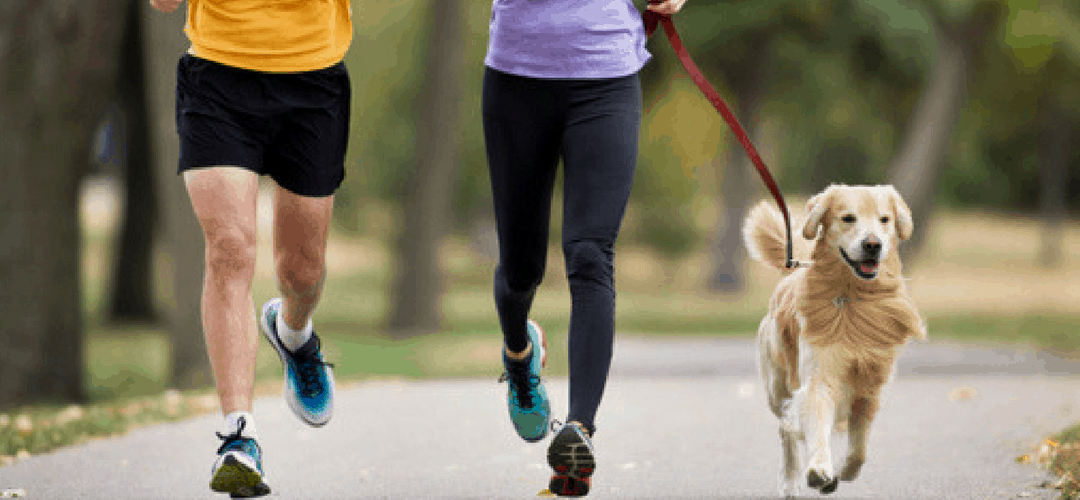When we talk about pets people become passionate. There are pictures and stories that are immediately shared which made our last post on running with dogs so much fun. And while we are on the topic we decided we should have Laura, our running ambassador from This Runner’s Recipes, share a few more tips on running with your dog – particularly as it relates to safety.
LACE UP TIPS WITH LAURA
In my last post, I shared some practical tips to get started running with your dog. When I run with my dogs, their safety is always a priority when we are out on the run – and I am sure that you want the same for your dog. These safety tips for running with your dog will keep you and your four-legged running buddy healthy and safe for many miles to come.
Wait until Your Dog is Old Enough
Depending on the size of the breed, you should wait until your dog is 9-12 months old before you begin running them for more than a few minutes. Young puppies are developing their musculoskeletal system and bone and joint strength for the first several months. Running places too much of a stress on their joints, tendons, bones, and muscles during this formative period and could predispose them for future issues such as hip dysplasia.
Keep Your Dog Hydrated
You wouldn’t run 10 miles without any water – nor should you expect the same for your dog. Even though your pup doesn’t sweat, they still need fluids during running, especially on hot days or longer efforts. Bring a collapsible bowl or use your hands to form a bowl, and stop for water breaks based on the weather and your pet’s needs.
Wait 2 Hours After Eating to Run
Runners love their pre-run snacks, but unfortunately your dog can’t enjoy toast and peanut butter with you before a run. Dogs have slower digestive systems than humans, so their meals won’t be sufficiently digested until about 2 hours after their meal. If you run too soon after a meal, your dog could suffer from vomiting, diarrhea, or a life-threatening torsion of their intestines.
Your pup may be confused at a change in his eating schedule, but waiting until after his run will keep him healthy and safe. If your dog is very hungry, give him a couple small training snacks to tide him over.
Don’t Feed Your Dog Immediately Afterward
While eating after a run is important for our recovery, dogs have different digestive systems than humans. If a dog eats too soon after strenuous exercises, they can have problems digesting their food and suffer from bloating or intestinal torsion. Wait until one hour has passed after exercise before scooping up a bowl of your pup’s kibble. Small treats are acceptable, but a large volume of food requires waiting.
Choose a Comfortable, Safe Harness
A collar may work well enough for daily walks, but your dog will pull more on the leash when he runs. A comfortable, secure harness that straps around your pet’s torso will anchor them safely to the leash, reduce the strain on their neck, and make the run more comfortable for both of you. Your dog is less likely to slip out of a harness than a collar.
Do not run with your dog in a pull or choke collar, as this could cause harm to your dog if he lunged at something or if you had to suddenly pull him out of the way of traffic.
You want to keep your dog leashed for safety; for you, your dog, and others. If you run along a busy road, you want to keep your dog leashed to keep him out of traffic and to respect other pedestrians or runners. Many cities and suburban areas have leash laws for both safety and courtesy to others.
Be Cautious in the Heat and Humidity
Unlike humans, dogs can’t sweat to cool down. Heat and humidity will affect them even more than such conditions affect people – and any runner can tell you the negative effect that temperatures above 75 degrees can have on any run. When running with your dog in hot weather, keep the run short and easy. Monitor your pooch for signals of overheating, including excessive panting and slowing down, and be prepared to cut your run short as needed.
Certain types of dogs will be more affected by the heat of summer than others. Pugs and bulldogs will struggle to breathe in humid weather and hot temperatures, due to their short snouts. Any dog with a black or dark brown coat will overheat more quickly than a dog with a light colored coat, especially if you are running on asphalt.
During summer, you may choose to take your dog trail running instead of road running. The dirt ground won’t trap heat as much as pavement and the trees will provide some shelter from the sun. If you run on trails, be cautious of wild animals including snakes and keep your dog close to you out of courtesy for other runners, walkers, and wildlife.
This list does not cover every possible safety scenario that you may encounter while running with your dog, but touches on some of the most important highpoints. Always monitor your dog for signs of fatigue on a run and be extra cautious of threats such as broken glass, cars, cyclists, and more when running with your dog. Put your dog’s safety first before your workout and be willing to cut the run short if you need to for any reason – because that will make the run enjoyable for both of you.
These are great tips to keep our most passionate and loyal running buddies safe and healthy. Pets are an important part of our lives so let’s give them all the care they require because that’s Wholesome to the Core.

